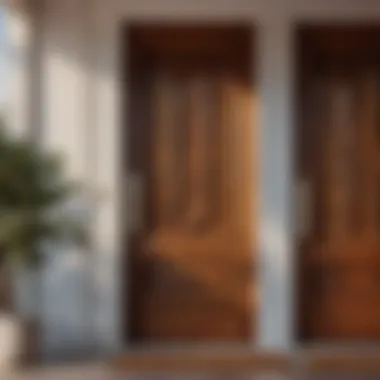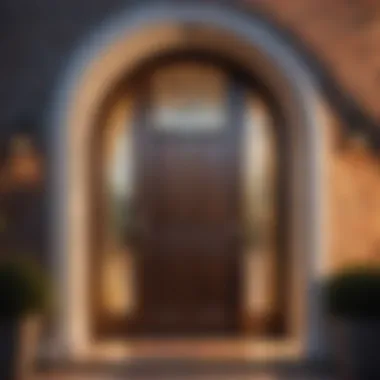Materials:
- High-quality solid wood door: 1 piece, measuring 36" wide x 80" high x 1 3/4" thick, for durability and security.
- Premium door hardware set: Including handles, locks, hinges, and screws for a complete installation.
- Insulation materials: Foam insulation strips and weather stripping to ensure energy efficiency.
- Caulk and sealant: Silicon-based sealant for weatherproofing and finishing.
- Paint or stain: Choose a finish that complements your home's exterior.
DIY Steps:
- Measure the existing door frame accurately to select the right-sized replacement door.
- Remove the old door carefully, unscrewing hinges and handles before disposal.
- Install the insulation strips around the door frame to prevent heat loss.
- Position the new door in place, securing it with hinges and screws provided in the hardware set.
- Add weather stripping along the edges for a tight seal.
- Apply caulking around the frame and threshold to seal any gaps.
- Finish by painting or staining the door to match your home's aesthetic.
Technical Aspects:
- Tools required: Tape measure, screwdriver, hammer, level, caulking gun, paintbrushes.
- Timing specifics: Allocate a full day for installation to ensure thoroughness.
- Critical techniques: Use a level at every step to ensure proper alignment and functionality.
DIY Project Process:


- Begin by preparing the work area, clearing space for easy maneuvering around the door frame.
- Follow the step-by-step instructions provided with the door and hardware set for seamless installation.
- Troubleshooting Tips: If the door doesn't close properly, adjust hinges for proper alignment.
- For a snug fit, ensure weather stripping is securely in place to prevent drafts.
Factors Impacting New Front Door Costs


In the realm of home improvement projects, the choice of a new front door holds significant weight. The factors influencing new front door costs play a pivotal role in determining the overall financial implications of this undertaking. By delving into material selection, design complexity, and energy efficiency, homeowners can make informed decisions that not only enhance their property's aesthetic appeal but also contribute to its functionality and security.
Material Selection
When it comes to selecting the material for a new front door, homeowners are faced with a myriad of options, each with its unique characteristics and benefits. Understanding the differences between wood, steel, fiberglass, and iron is essential in making a decision that aligns with both budget constraints and desired aesthetics.
Wood
Wooden front doors exude a classic and timeless appeal, complementing various architectural styles. The key characteristic of wood lies in its natural warmth and charm, adding character to any home. While wood is a popular choice for its elegance and versatility, it requires regular maintenance to prevent warping or rotting, making it more high-maintenance compared to other materials.
Steel
Steel doors are renowned for their durability and security features, making them an ideal choice for homeowners prioritizing safety. The key characteristic of steel is its resistance to dents and scratches, offering a long-lasting solution for increased protection. Despite its robust nature, steel doors may be prone to rust if not properly maintained over time.
Fiberglass
Fiberglass doors strike a balance between aesthetics and functionality, providing excellent insulation properties and resistance to harsh weather conditions. The key characteristic of fiberglass is its low maintenance requirement, offering a convenient option for homeowners seeking durability without the need for frequent upkeep. However, fiberglass doors may be more costly upfront than other materials.
Iron
Iron doors exude elegance and luxury, making a bold statement at any entrance. The key characteristic of iron lies in its strength and security features, enhancing not only the visual appeal but also the safety of a property. While iron doors offer unparalleled security, they also require regular maintenance to prevent rust and corrosion, adding to long-term care costs.
Design Complexity
The design complexity of a front door can significantly impact its cost, with standard designs differing from customized options. Homeowners must consider the level of customization desired to achieve the desired aesthetic and functional characteristics.
Standard Designs
Standard front door designs offer a cost-effective solution for homeowners seeking simplicity and functionality. The key characteristic of standard designs is their affordability and ease of installation, providing a quick and efficient way to upgrade a home's entrance. While standard designs may lack the uniqueness of custom options, they are a practical choice for those on a budget.
Customization
Customized front doors offer a personalized touch, allowing homeowners to tailor the design to their specific preferences. The key characteristic of customization is the ability to create a unique entrance that reflects individual style and enhances curb appeal. While customization allows for creative freedom, it typically comes at a higher price point, making it a choice for those willing to invest in a bespoke solution.
Energy Efficiency
Incorporating energy-efficient features into a new front door not only contributes to environmental sustainability but also helps homeowners save on utility costs. Factors such as insulation type and glass panes play a crucial role in enhancing energy efficiency and overall comfort within a home.
Insulation Type
The type of insulation used in a front door significantly impacts its energy efficiency, with options like foam or thermal breaks enhancing thermal performance. The key characteristic of insulation type is its ability to regulate indoor temperatures, reducing heat loss or gain and improving overall comfort. Opting for high-quality insulation can lead to long-term savings on heating and cooling expenses.
Glass Panes
Choosing the right glass panes for a front door can improve natural light penetration and insulation properties. The key characteristic of glass panes is their ability to enhance visibility and aesthetics while maintaining energy efficiency. Double or triple-pane glass offers superior insulation compared to single-pane options, providing better soundproofing and thermal efficiency for a more comfortable indoor environment.
Cost Breakdown of New Front Doors


In this comprehensive guide to understanding new front door costs, the Cost Breakdown section plays a vital role in shedding light on the financial components involved. Delving into the breakdown allows homeowners to grasp the intricate details that influence the overall expenditure. By dissecting the costs, individuals can make informed decisions regarding their budget allocations and priorities.
Initial Purchase Cost
When it comes to Initial Purchase Cost, this aspect stands as the foundation of the entire investment. This includes the actual price of the front door unit itself, which varies based on material, design, and energy efficiency features. Homeowners must carefully assess their needs and preferences to align the upfront cost with the desired quality and aesthetic appeal.
Installation Expenses
Professional Labor Charges
Professional labor charges constitute a significant portion of the Installation Expenses. Employing skilled professionals ensures a hassle-free and precise installation process, guaranteeing the longevity and performance of the front door. The expertise and craftsmanship offered by professionals justify the cost, providing a sense of security and reliability for homeowners seeking optimal results from their investment. While these charges may add to the overall expenditure, the peace of mind and quality assurance they bring make them a worthy investment for the long run.
Additional Fees
In addition to labor charges, Additional Fees play a role in the total cost of installing a new front door. These fees might include disposal charges for old doors, transportation costs for the new door, or any unforeseen expenses that can arise during the installation process. Understanding and accounting for these additional fees beforehand can prevent budgetary surprises and ensure a smooth and efficient installation experience.
Maintenance Costs
Maintenance Costs are an ongoing consideration for homeowners investing in a new front door. While the initial purchase and installation costs are one-time expenses, maintenance expenses encompass routine upkeep, repairs, and potential replacements in the future. Prioritizing high-quality materials and proper care can mitigate long-term maintenance costs, safeguarding the longevity and performance of the front door over time.
Average Prices of New Front Doors
When considering a home improvement project like installing a new front door, understanding the average prices of different door types is crucial. The cost of a front door can vary significantly based on various factors such as materials used, design complexity, and energy efficiency features. By delving into the average prices of new front doors, homeowners can make informed decisions that align with their budget and style preferences.
Price Ranges by Material
One of the primary factors that influence the cost of a new front door is the material chosen for its construction. Different materials come with varying price ranges, each offering distinct benefits and considerations.
Wood
Wooden front doors exude a classic and elegant appeal, making them a popular choice for many homeowners. While wood provides superior insulation and aesthetic appeal, it tends to be more expensive compared to other materials. The price range for wooden front doors can vary significantly based on the type of wood used, with hardwoods like mahogany being at the higher end of the spectrum.
Steel
Steel front doors are highly durable and offer excellent security features, making them a practical choice for homeowners prioritizing safety. Steel doors are typically more affordable than wood and require minimal maintenance, adding to their cost-effectiveness.
Fiberglass
Fiberglass front doors strike a balance between affordability and durability. They are designed to mimic the look of wood while being more resistant to dents and scratches. Fiberglass doors come in a wide range of styles and price points, offering homeowners flexibility in finding a door that fits their budget.
Iron
Iron front doors are known for their unparalleled strength and intricate designs. While iron doors can be on the higher end of the price spectrum, their durability and aesthetic appeal make them a popular choice for homeowners looking to make a statement with their entryway.
Comparative Costs
Comparing the costs of different door materials allows homeowners to weigh the pros and cons of each option effectively. By analyzing the comparative costs of materials like wood, steel, fiberglass, and iron, individuals can make informed decisions that align with their budget constraints and long-term preferences.
Evaluating Installation Costs
When delving into the realm of new front door costs, it is crucial to carefully evaluate the installation expenses involved. Understanding the significance of installation costs can greatly impact the overall budget and decision-making process. By thoroughly assessing these costs, individuals can make informed choices and ensure the installation aligns with both their financial capabilities and aesthetic preferences.
Considering the elements of evaluating installation costs, one must take into account various factors that contribute to the final expenditure. Labor fees, in particular, play a pivotal role in determining the total cost of installing a new front door. Professional installation services often come with a price tag based on the complexity of the installation process, the time required, and the expertise of the laborers involved.
In addition to labor fees, other aspects that influence installation costs are the materials and tools needed for the installation. Factors such as the type of front door, the location of the property, and any customized features desired can all impact the overall installation expenses. It is essential to carefully weigh these considerations to prevent unforeseen costs and budget overruns.
By meticulously evaluating installation costs, individuals can gain a comprehensive understanding of the financial implications associated with installing a new front door. This scrutiny allows for better planning, budgeting, and decision-making, ultimately leading to a successful and cost-effective installation process.
Labor Fees
Labor fees represent a significant component of the overall installation costs when installing a new front door. These fees encompass the charges levied by professionals for their services, including the removal of the old door, preparation of the doorway, and precise installation of the new door. The complexity of the installation process and the skill level of the laborers can directly impact the labor fees incurred.
Factors influencing labor fees include the size and weight of the door, the intricacy of the design, and any additional customization requests. Professional installers may charge based on the time taken for the installation or provide a flat rate for their services. It is essential to obtain detailed quotes from multiple installers to compare prices and ensure a fair and competitive deal.
Prioritize engaging experienced and reputable professionals for the installation to guarantee quality workmanship and a seamless door fitting process. While labor fees constitute a significant portion of the installation costs, they reflect the expertise and precision required to ensure the new front door is fitted securely and durably.
Factors Influencing Installation Costs
Several factors can influence the overall installation costs when installing a new front door. Understanding these influences is crucial for effective budgeting and decision-making. The location of the property can impact installation costs, with urban areas often commanding higher labor fees due to increased demand and overhead expenses.
The type of material chosen for the front door also plays a pivotal role in determining installation costs. For instance, wood doors may require more intricate installation techniques compared to steel or fiberglass doors, affecting the labor fees involved. Additionally, any specialized features such as sidelights, transoms, or custom hardware can add to the overall installation expenses.
Other factors influencing installation costs include the accessibility of the entryway, the need for additional structural modifications, and the presence of any security or energy-efficient upgrades. By considering these influences and thoroughly evaluating installation costs, individuals can optimize their budget, select the most suitable installation options, and ensure a smooth and successful door installation process.
Ways to Minimize New Front Door Expenses
When it comes to new front door expenses, finding ways to minimize costs becomes paramount. In this section, we delve into strategies that not only help save money but also ensure a quality outcome for your front door project. By taking proactive measures to cut down expenses, homeowners can navigate the process of front door replacement more efficiently and economically.
DIY Installation
One effective way to minimize new front door expenses is through DIY installation. By opting to install the door yourself, you can significantly reduce labor costs associated with hiring professionals. However, before embarking on the DIY route, it's crucial to assess your skill level and available tools to ensure a successful installation. Make sure to thoroughly read manufacturer instructions, watch video tutorials, and gather all necessary supplies before tackling the project.
Embracing a DIY approach not only saves money but also allows for a hands-on experience, giving you a sense of accomplishment upon completion. Keep in mind that proper installation is crucial for the door's functionality and durability, so take your time and pay attention to detail throughout the process.
Research and Comparisons
Another key strategy to minimize new front door expenses is diligent research and comparisons. Before making any purchasing decisions, invest time in researching different door materials, styles, and brands to find the best value for your budget. Take note of prices from various suppliers, compare features and warranties, and read customer reviews to gain insight into product quality.
By conducting thorough research and making informed comparisons, homeowners can ensure they are getting the most out of their investment. Look for promotions, discounts, or clearance sales to capitalize on cost-saving opportunities. Additionally, obtaining multiple quotes from different installers can help you negotiate better prices and identify any hidden fees. Armed with knowledge and comparisons, you can make well-informed decisions that align with your budget and requirements.





